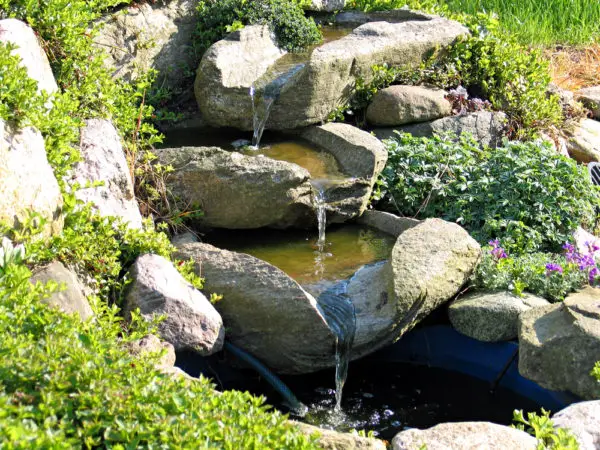You might not think about it when first contemplating whether or not you should install a water feature in your backyard, but sooner or later you’re going to have to consider how loud this new addition to your backyard will prove to be.
Water features are not inherently noisy. The noise level of decorative ponds, waterfalls, or fountains can be controlled by adjusting the water levels, the pump speed/location, and by adding additional features such as rocks, metal, or aquatic plants.
So water features aren’t initially very loud. Does that mean that your gorgeous, backyard waterfall is doomed to be muted by that obnoxious highway you live next to? Or is it possible to somehow drown out the background noise?
Which Is More Ideal: Loud Or Quiet?
If you’re anything like me you might look at this heading and the first thought to run through your head is, “Why on earth would I want to have a noisy water feature?” There are actually several advantages to having a louder waterfall, fountain, or pond enriching the atmosphere of your backyard.
Did you know that the noise of a fountain can help drown out the disruptive sounds of car horns, sirens, or a noisy neighbor? I don’t know about you, but the last thing I want to hear when looking to kick back and relax in my outdoor-safe-haven is the irritating blare of temperamental drivers.
If you don’t live near a busy road or highway and the neighborhood you live in is already relatively peaceful, a quieter trickle of water may be the ambiance you need to complete your peaceful atmosphere.
There is something to be said about the soothing affect the soft sound of water has. So if background noise isn’t an issue, or if your sound-sensitive and prone to headaches, a hushed water feature may be the best option for you. Either way there are very simple steps you can take to find the perfect sound volume for your backyard.
Water Levels
What’s the difference between a crashing, majestic waterfall and a peaceful, trickling stream? Both are beautiful. Both are bodies of water. But the difference in the amount of sound created by the two forms of running water is massive. The element that creates that difference in sound is the amount of water falling.
This is the first, and perhaps the most simple of all steps in controlling the sound output of your water feature: regulating the level of water. If you decide to go with that louder, drown-out-the-background-noise volume, you’re going to want to keep the water level low.
With a lower water level sitting the the bottom of the water feature, the water cascading from the top of the fountain or waterfall will make a louder crashing sound as it hits the liquid below.
On the other hand, if the subtle, spa-like ambiance is what you’re going for, keep your water levels high to diminish the crashing, splashing water noises.
Pump Speed
Adjusting the sound by fiddling with the pump is also a fairly easy and straightforward step to achieving the ideal tone of your backyard. For increased volume, turn up the speed of your pump. Not only will the pump itself emit more noise, but the larger amount of water that will be coursing through the pump will create more of rushing sound, opposed to the trickling sound of lower water levels.
If your pump is operating at it’s maximum speed, and it still isn’t loud enough for you, you can always purchase a larger pump.
Since turning up the speed of your pump will increase the noise, logically turning the speed of your pump to it’s lowest setting should help you achieve that soothing, soft water sound.
Another helpful hack you could use to mute the sound of your water pump is placing a sponge between your pump and the wall of your water feature. The sponge will absorb some of the vibration coming off of your pump and work as a muffler.
Pump Height
Placing the pump closer or further away from the water can make the noise louder or softer. The further away the pump is from the water, the louder the water will be, and the bigger the splashes will be. If the pump is closer to the water, the water won’t be falling as far, and the splashes won’t be as big, so the water feature overall will be much more quiet.
Additional Features
Adding additional features like rocks, metal, and aquatic plants can also either dull or amplify the amount of sound that emanates from your waterfall, fountain, or pond. This is personally my favorite hack because it adds another aesthetic layer to your backyard and it is an efficient tool of volume control.
For a louder water feature try using metal and/or rocks to spice up the appearance of your fountain or waterfall. If you decide to go with metal objects, it’s important to keep in mind that some metal will begin rust over time when exposed to water. If you don’t want that to happen, be sure to steer clear any items made of copper or iron.
Arranging rocks at the base of your fountain is another great way to amplify the volume of the water cascading from higher levels.
To turn the volume down try adding some aquatic plants to your water feature. Plants are beautiful and work as an excellent natural muffler for splashing sounds. For example, if water lilies are placed in the base of your pond, the louder splash of water hitting water will be replaced with the soft patter of water hitting a petal.
Aquatic plants will also help build the volume of your pond, further decreasing the sound of falling water and even helping to fight off nuisances like algae.

